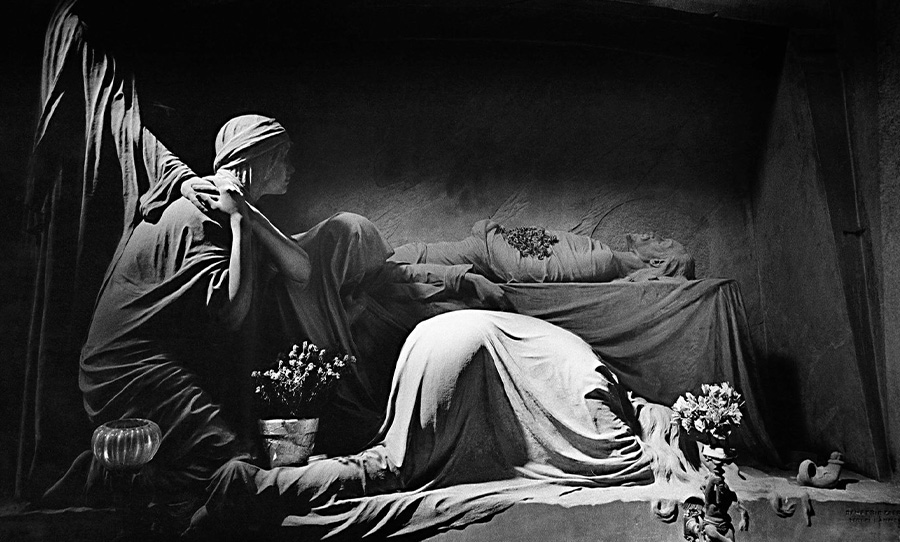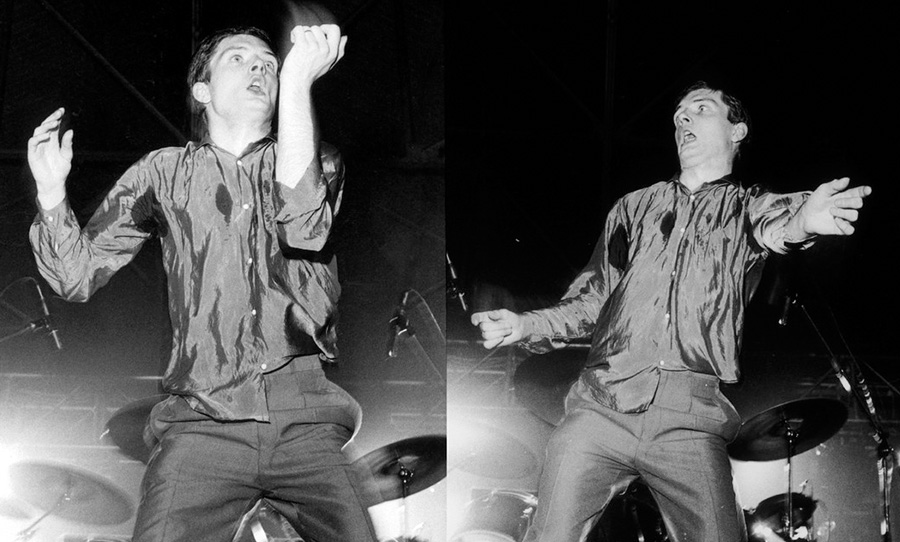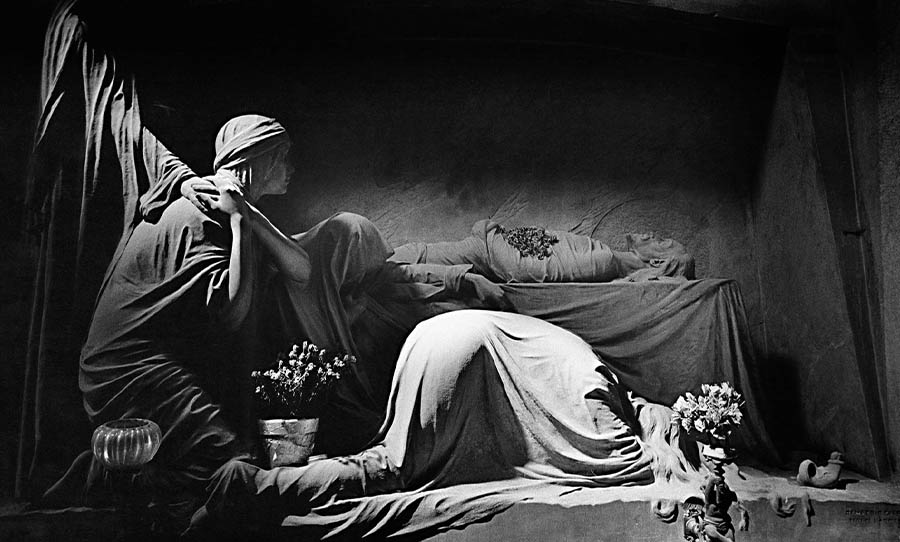Few albums are able to conjure images of gloom, darkness, and pain while feeling like a euphoric release. Even fewer are able to do this while revolutionising music. Closer, Joy Division’s headstone, their magnum opus, was the end of music as we knew it. It destroyed any conception of what music could be while rebuilding its foundations into something purely original.
The final album from the Manchester post-punk outfit is steeped in darkness. From the Peter Saville cover of a tomb, through to the moments of skeletal intensity which pervade every song. This monolith of a record will forever be attached to one event, and that event has affected everyone’s perception of the album since, for better or for worse.

After 40 years, Joy Division’s final album Closer remains a monolith of life and death. Music hasn’t sounded this alive since.
40 years to the day, Ian Curtis watched Werner Herzog’s film Stroszek and listened to Iggy Pop’s icy masterpiece The Idiot. Exactly two months out from the release of the band’s sophomore album and on the eve of the band’s first American tour, Curtis committed suicide aged 23.
The cloud that would shroud the release of Closer has lingered for the past four decades. Every lyric, image, album cover, and single cover have been studied to the most minute detail. Curtis’ now widely known depression and epilepsy were never viewed by his band members as foreshadowing his catastrophic loss.
Bernard Sumner, the band’s guitarist, discussed his perception on Curtis’ lyrics: “We’d go to rehearsals and sit around and talk about really banal things. We’d do that until we couldn’t talk about banal things any more, then we’d pick up our instruments and record into a little cassette player. We didn’t talk about the music or the lyrics very much. We never analysed it.”
Curtis’ lyrics were obviously reflective of his mental state. Sumner recollected a conversation he once had with Curtis, saying, “while we were working on Closer, Ian said to me that doing this album felt very strange, because he felt that all his words were writing themselves. He also said that he had this terrible claustrophobic feeling that he was in a whirlpool and being pulled down, drowning.”
The album’s production was handled by Martin Hannett who produced the band’s astonishing debut, Unknown Pleasures. Even though there was tensions between the band and Hannett, especially for his ice-cold techniques (quite literally, he would often turn the temperature of the studio so low people could see their breath), the combination between producer and band could not have been more perfect. Possibly only behind The Beatles-Martin or Bowie-Eno, Joy Division-Hannett unknowingly built two of the most important albums of the past 40 years.
Hannett restructured Joy Division’s sound as something wholly new. Rather than simply being a punk band, Joy Division and Hannett crafted music that refracted darkness and deconstructed music to it’s rawest form. However, the band had no idea just how powerful and influential their music would become.

Within a month of Curtis’ death, Joy Division released what is arguably one of the greatest singles ever made. Love Will Tear Us Apart allows all the most powerful emotional elements of music to meet at a crossroad. You have Stephen Morris’ pounding drums, you have one of Peter Hook’s greatest bass lines (a feat in and of itself considering the sheer amount of iconic bass lines attached to his name), you have a synth pattern of incomparable euphoria and you have Curtis. At the centre of Joy Division, through the noise and the chaos, stands Curtis. The ice-cold production of Martin Hannett allows Curtis’ lyrics of melted love lost to stand like pillars amongst the monolith of the song.
The song would eventually become the band’s most successful song, charting at number 13 in the UK. The album that followed a month later remains the band’s defining masterpiece. Closer, nine songs, 45 minutes, takes the listener closer to what the band tried to achieve more than any of their other releases. The album’s first song Atrocity Exhibition, named after the J.G. Ballard novel invites you into the band’s world and Curtis’ open wounds. “This is the way, step inside,” Curtis doesn’t just invite you into his world, he invites you to view music and pure artistic expression as naked entities. He wants you to leave any conception you had at the door, showing you a new manner of revealing inner desires and experiences. The music itself, tribal and pulsating, feels like every instrument is beaten to the point of each respective extreme. No music had ever sounded like this. No music ever would sound like it again. Raw, uninhibited, completely and entirely fresh.
Colony and Twenty Four Hours do much of the heavy lifting in terms of sheer earth-shattering post-punk. If you want a dictionary description of how post-punk is meant to sound, don’t look any further than these two bulldozers.
Means to An End and Heart and Soul look to the future. In Heart and Soul, Curtis murmurs, “The past is now part of my future, the present is well out of hand” over a staggered electronic bass mumble. Darkness all of a sudden could be danceable. “Heart and soul, what will burn,” Curtis wasn’t concerned of the possibility of emotional deterioration, he was only interested on what would be destroyed first.
The album may be an epitaph, but it also birthed one of the most important pop acts of the 80’s, New Order. Following Curtis’ death, the remaining members rebuilt themselves as one of the most successful groups of the 80’s. You can see the beginning of New Orders electronic elements on full display on Closer.
The album’s final one-two punch should be regarded as one of the most powerful final chapters of any artist’s career. Much like the Beatles’ The End, Joy Division’s career is summed up in the final 10 minutes of Closer. The Eternal’s funeral march eerily signifies Curtis’ own death. However he has lost the words to describe everything he sees. “No words could explain, no actions determine/ Just watching the trees and the leaves as they fall,” Curtis’s baritone haunts the song to its very last note.
Decades, the final song on Closer along with the final song in Joy Division’s catalogue, is one of the most affecting, beautiful, heart-wrenching and powerful final statements from any band. The track begins with the slow groove of drums, followed by thin guitar and bass lines. When the synths begin to build around the track, the drums start to expand. Curtis sings about war and death through some of the most powerful and astonishing images ever put to music. Curtis releases, “We knocked on the doors of Hell’s darker chamber/pushed to the limit, we dragged ourselves in”. As the song grows, it is released in all its glory in the final two minutes. Following darkness comes release. This mantra pervades the entirety of Closer.
The album would be released to rave reviews and go on to crack the UK top 10. It is now considered, understandably, one of the greatest albums ever recorded. Even artists as diverse as George Michael considered the album a masterpiece.

In a recent interview with Consequence of Sound, Peter Hook summed up Joy Division perfectly, “Look, Joy Division was very pure, you know? They didn’t embarrass themselves the way that New Order have. Joy Division kept the mystique, the purity, the heart all quite intact. We weren’t sullied by success. The music wasn’t watered down by it, and the money didn’t change anything.”
The album shouldn’t be seen as the depths of gloom. Its message is one of release, escaping the constraints which hold each individual down. The album is a memorial to the undying and ever-expanding influence of one the world’s most extraordinary bands.
However you view the album, through the lens of extreme darkness or as a void that sucks in light, it also signifies rebirth. Out of it, we experience new ways to conceive music and sound. There are new ways of unleashing an artist’s emotional vulnerability and purity. There is the rebirth of one of the most influential electronic acts in history.
Closer is more than darkness. Its darkness is so powerful because it seeks light. It searches for hope, for love, for goodness and happiness. These are all thing people strive for in life. Curtis strived to achieve all these things, however, he was shrouded by a vale. Closer is life and death. It is an album that strips itself bear and wants you to understand that through this eternal struggle there is some life. All the while, you’re experiencing music that has reverberated through time, becoming timeless.
In all of recorded music, it is rare for an album to encapsulate so much of life. 40 years on, nothing comes close to Joy Division’s masterpiece. It is nearly impossible to discuss an album like this one — the only way to fully experience its majesty is to revisit it. In the words of Curtis, “This is the way, step inside”.



